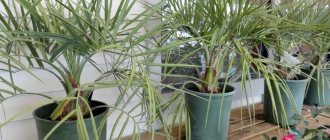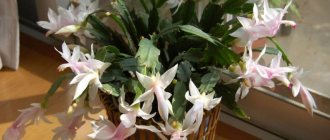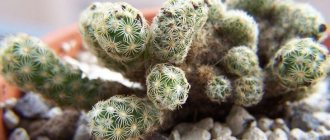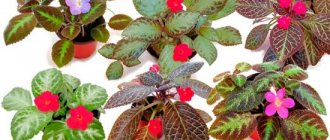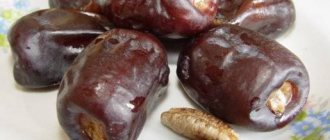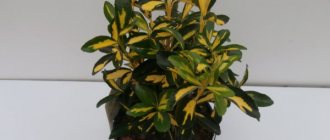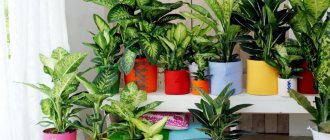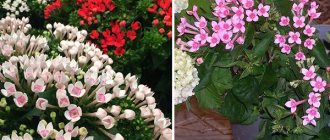Description
In nature, there are more than a dozen different species of date palms. It is mentioned as a culture back in the 4th century BC, which grew in the territory of present-day Iraq.
Biologically, the plant belongs to trees or shrubs and has one or two trunks. There are some species that have several trunks. They have spines at the base, strong and sharp. Small, yellow flowers, collected in paniculate inflorescences. The leaves are pinnate, long and narrow, pointed upward.
In nature, they live up to one and a half centuries and grow up to thirty meters in height. Many of the species produce fruits that are eaten - dates, which are rich in carbohydrates, vitamins and microelements. They are suitable for people, they are used to feed animals, and they are used to make sugar.
In the Ancient East, these fruits were considered bread because of their satiety and availability. To collect fruits from a tree, you need to climb to the very top, as they do not fall to the ground.
Types of palm trees to grow indoors
Even in the century before last, they practiced growing this plant like a flower. Not all types of palm trees are suitable for indoor use. Here are some of their varieties that can take root in a room.
- The common or palmate date is popular and fast-growing.
- The Robelena date is a low-growing species up to 2 m.
- Date Canary - about 2m.
- Curved date – up to 8 m, has several trunks
- Forest date - up to 12 m.
- Rocky date – up to 7 m.
- Ceylon date – up to 6 m.
All of them are very resistant to diseases and pests. The dates sold in stores are the fruits of the common date. It is grown industrially in the United Arab Emirates and Africa. From the seed of the fruit of this palm tree a flower can be obtained.
But you need to know that it has a two-meter height, branchy leaves and will take up a lot of space. Therefore, you need to immediately decide on the place where this future tree will be located.
2 reproduction options: step-by-step description
The plant can be propagated by seeds and suckers. The latter method is rarely used, since the majority of palm species do not branch, but there are exceptions, including the Robelena date.
Offshoots form on roots that are close to the soil surface. As soon as they take root, they are separated from the mother using a sharp knife, and the cut site is sprinkled with activated carbon. After which they are planted in the soil, watered abundantly and covered with film. Ventilate and moisten periodically. And after a few weeks, the film is removed and cared for like an ordinary palm tree.
For propagation by seeds, the fruit pit is used. The procedure is carried out in February-March. And the process consists of several stages:
- The raw date pit is completely cleared of fruit residues and left to dry for a day.
- Then they are soaked for 3-4 days in warm water, which is changed every day. During this time, it swells, and it is easier for the sprout to break through.
- After soaking, it is vertically immersed in the ground one and a half cm in length.
- Place the planted seeds for germination on the battery.
- Regularly moisten the soil.
- The seeds germinate 1–3 months after planting.
- When the sprouts reach 10 cm, they are planted in small pots.
A huge advantage of seed propagation is accessibility and good adaptation to unusual conditions for dates. And the downside: there is no way to determine the variety.
Landing
Buying seeds
There is no need to go to a specialized store to buy seeds; just go to the nearest grocery or vegetable store and buy date fruits, after checking the packaging date.
The fact is that old seeds may not sprout. Eat a few pieces, freeing the seeds from the pulp. Examine the appearance carefully. They must be undamaged and not eaten away by insects, as well as without signs of any disease or heat treatment.
When seeds are placed in water, healthy ones will sink to the bottom, and empty ones will rise to the surface.
Preparing for landing
Before planting, immerse the seeds in warm water for several days, which is changed once a day. For rapid root formation, growth stimulants (zircon, epin) can be added. You can use another soaking method.
Wrap the bone in a cotton swab moistened with water and place it in a small vessel until it swells. If necessary, re-wet the cotton wool.
Soil selection
Stores sell special soil for this crop, but universal soil is also suitable. You can also collect soil with your own hands in several ways.
Prepare a mixture of equal parts of sand, compost, and turf soil. Add superphosphate there (1 tbsp per 3 liters of soil).
A mixture of 2 parts turf flour, 1 part sand, 1 part peat and wood ash.
The finished soil must be disinfected by pouring boiling water on it or calcining it in the oven. You can also spill a solution of potassium permanganate.
Landing
When the roots are pecked, several seeds are planted in peat tablets. The first shoot will appear within six months. But if the seed is from a fresh fruit, it may appear after 20-25 days. We send the strongest shoot into the ground for further growth. Since the future plant has powerful roots, choose a deep vessel to provide drainage. When choosing a location, take into account that the palm tree does not tolerate the rays of the sun, drafts, or cold.
Preparing date pits for planting
Date palm - how to grow at home
Before you can sprout a date from a seed, you need to get it somewhere. It’s not difficult - dates are bought, but not roasted, eaten, and the remaining grains can be immersed in the ground.
Date pit
The correct dates from which to take the pit are fresh fruit, dates brought from other countries, dried fruit.
Additional Information! The best time to plant a plant from a seed is from February to March.
Selection and preparation of planting material
The appearance of a palm tree is possible only from those seeds that have not been subjected to heat treatment.
A step-by-step algorithm for seed procurement is described below.
Step 1. The seeds are removed from the fruit and washed under running water. If this is not done, the remaining particles from the fruit can trigger the process of rotting in the ground. Washed seeds should be left for at least 24 hours.
Step 2. Because the seeds of the plant are very hard, it is difficult for them to germinate. To speed up this stage, the following methods will help:
- scratch the surface of the bone with sandpaper so that moisture penetrates into it more easily;
- make several cuts so that the shell splits faster;
- scald with very hot water.
The best way to speed up the germination process is to soak the seed in cotton wool. You need to put cotton wool soaked with water in a plate, put a seed in it, and cover it with another piece of wet cotton wool.
For reference! Instead of cotton wool, you can use hydrogel, sawdust or gauze.
Step 3. Place the container with the bone in cotton wool in a warm place, for example, on a radiator.
As the cotton dries, it should be moistened with water. As soon as the seed swells, it can be planted in the ground.
To increase the chances of having a date tree, you need to prepare some seeds. Some of them will not be able to sprout.
Step 4. The seeds are placed in the ground to a depth of 1 - 2 cm. All seeds can be placed in one container, which makes it easier to care for. Before the seedlings appear, the soil should be watered frequently, but not flooded.
Attention! The seed is placed in the soil in a vertical position.
In containers with seeds, you need to make small holes at the bottom so that the water does not stagnate.
The soil is nutritious soil; it is recommended to add sawdust or sand to it. The room temperature should be between 24 °C and 26 °C. The lower the temperature, the longer it will take for the swelling to appear. Sometimes this takes up to 10-12 months.
Watering should be done at such intervals that the soil is moist but not wet. On average, it takes from 1 to 3 months for seedlings to emerge. It all depends on the quality of the planting material and compliance with all recommendations.
As soon as the green stem that has broken through reaches a height of 10 cm, you can transplant it into another flowerpot.
Soil selection
Before you grow a date from a seed, you need to select the soil. Purchased land intended for palm trees is best suited. You can make soil suitable for dates yourself:
- 2 parts clay-turf soil;
- 2 parts of humus-leaf soil;
- 1 part peat;
- 1 part rotted manure;
- 1 part sand.
Attention! There should be drainage at the bottom of the pot. Its function can be performed by charcoal, expanded clay, and small fraction pebbles. It prevents stagnation of water in the ground, which is detrimental to the palm tree.
Planting a sprouted seedling
There is nothing complicated about transplanting a seedling. But you need to take into account that the date palm treats the procedure of changing places very poorly. Quite often, quite actively growing seedlings died after being transplanted into another flowerpot. To avoid this, the seedling is placed in a new container with a lump of earth in which its roots are located. This way the palm tree will gain a foothold faster without experiencing severe stress.
In winter and spring, the palm tree will develop slowly. Watering should be reduced to a minimum, only to maintain soil moisture. The plant does not need fertilizing; it will not speed up its development.
The first few years after transplanting the seedlings, the palm tree looks like tough grass. In the 3rd year, the leaves expand, their plates become solid.
Future leaf
A real, full-fledged leaf will appear on the plant approximately 4 years after planting. From this moment on, in order for the palm tree to actively develop, it must be looked after properly.
Development
There will be no need to observe the Date Palm as such for several years. It only produces single, narrow, sharp leaves. Spreading leaves appear only at 3-5 years. And all the beauty can be observed only at 5-7 years of growth.
If you want to quickly get an adult plant, you can use the vegetative propagation method by tearing off the basal shoot or side shoulder strap at the base of the trunk.
Timing and technology of transplantation
If the plant is less than 5 years old, then replanting is carried out every year, then as needed, because such a procedure is difficult for an adult plant to tolerate. An indicator that the flower needs to be replanted are roots protruding from the drainage holes. This indicates that the pot has become small.
Important! The soil is selected the same as for planting.
Transshipment is considered the best method of replanting, because the palm tree has very delicate roots that can easily be damaged. A drainage layer is poured onto the bottom of the new pot, after which the palm tree is placed in it along with a lump of earth. Add new soil and water the plant.
Planting in a large pot can cause the flower to stop growing.
Every six months it is recommended to update the topsoil to saturate the soil with new nutrients.
An adult plant after 5 years is not replanted every year, but only the top layer of soil is renewed
Lighting
At the beginning of growth, place the date palm flower on the sunny side, but so as not to burn the leaves. This culture came to us from hot countries, so for further cultivation you need to choose a spacious, well-lit room with high ceilings.
In nature, the date palm grows in direct sunlight. In indoor conditions, the plant does not like direct rays, preferring a little shade on hot summer days. To ensure that the palm does not turn out to be one-sided, it is necessary to occasionally rotate the pot around its axis.
In winter, arrange additional lighting using a fluorescent lamp or LED.
Growing conditions
In order for the date to grow even, spreading, with natural colors, you need to follow the rules and provide it with comfortable conditions. The first shoots will appear in 1-3 months. When the plant reaches 10 cm in height, pick using the transshipment method.
Lighting
The plant loves the sun, so it will do better in a room with windows facing south or southeast. In summer, take the palm tree to the balcony or loggia. However, keep away from direct sunlight. The balcony must be glazed. Rotate the pot with the plant periodically, otherwise the leaves will grow unevenly and the crown will form crookedly. In the shade, the leaves grow longer as they reach towards the light.
Temperature
The date palm comes from the tropics, subtropics, and equatorial part of the planet, so it loves warmth. She is comfortable in mid-latitudes in summer. In winter, room temperature is sufficient. In the greenhouse in winter you need to maintain a temperature of +10 - +18 degrees. The room should not be hotter than 22 degrees. The room temperature for a date palm may be slightly higher in summer.
Until the sprout appears in the pot, provide an air temperature of +30 degrees, moisten the soil as it dries.
Temperature
The temperature for care in room conditions should be 23-25°C. In hot weather, the plant tolerates 30°C, but the leaves must be sprayed with water to prevent them from drying out. In winter it behaves well at 18°C. Make sure that the temperature is not lower than 14°C.
Take it out of a sheltered place into fresh air or a loggia, gradually hardening it at a temperature of up to 12°C. Start with one hour, increasing the time period each time.
A categorical “no” to droughts and overflows
The key to the decorativeness and durability of a date palm is to control the degree of drying of the substrate. Complete drying of the soil causes date palms to droop and then lose leaves that are unable to recover. Even small overflows lead to rot. Since this palm tree cannot tolerate contact with the roots, emergency replanting and pruning of the affected parts is disastrous for it. Therefore, it is not worth taking risks and exposing the date palm to stress.
The plant should not be watered too much, but regularly, drying the top layer of the substrate. In winter, watering is reduced, still not allowing the soil to dry out completely, maintaining light humidity and focusing on the room temperature. In cold weather, watering is limited to 1-2 procedures throughout the winter.
Date palms love spraying. They are vital in the heat, during the summer and in winter when heating systems are operating, when dates can be sprayed several times a day. If it is possible to tolerate palm trees, they will not refuse a weekly warm shower. Without spraying, plants will become easy prey for pests.
Read more about caring for indoor dates in the article Indoor date palm.
Watering
In nature, this tree grows with minimal rainfall. Therefore, the roots penetrate very deeply to search for moisture. How to water an indoor flower? This must be done so that the soil moisture is normal.
Make sure that the soil does not dry out, but is not over-moistened. Water for irrigation must be taken either from rainwater or from centralized water. In hot weather, shower. Winter watering should be much less frequent than summer watering.
Top dressing
Flower shops sell special fertilizers for palm trees, but you can also buy preparations for ordinary plants with a high nitrogen content to form lush green mass. Fertilizing is done into the spilled soil according to the instructions.
Like any other indoor plant, it is better to under-fertilize a palm tree than to over-fertilize it. Compost, humus, and ash will also help the normal development of the tree.
Trimming
During the first years, pruning is strictly prohibited. When the tree is old enough, you can trim off the side shoots that are dry or of poor quality, but not the top, which is the growing point.
Pests
If the leaves turn pale, curl, or begin to fall off, this may be due to pests. The palm tree is most often attacked by:
- nematode;
- mealyworm;
- spider mite;
- California flower thrips;
- scale insect
To combat insects, they use both store-bought preparations and all kinds of solutions and infusions prepared with their own hands. If you have a nematode infection, no drugs or remedies will help. The plant must be completely destroyed.
Possible problems arising when growing from seed
If the rules of plant care are not followed, various problems may arise in growing:
- dry ends occur due to lack of moisture, it is worth spraying the flower more often;
- the leaves turn yellow due to dry soil, you need to monitor watering;
- darkening of the leaves is the result of excess moisture;
- the palm tree does not grow. Most likely she’s just cold, it’s worth checking the air temperature in the room;
- yellow or brown spots appear on the leaves - a sign of potassium deficiency;
- the presence of bright yellow spots along the edges indicates a lack of magnesium;
- light leaves, lack of growth - not enough nitrogen, it’s worth feeding the flower;
- the appearance of leaf chlorosis indicates a lack of manganese. Fertilizers will help.
What can destroy a palm tree seedling?
The date palm is an unpretentious plant, however, it is also susceptible to various diseases and can be affected by harmful insects. The danger for palm trees is:
- spider mite Appears when the ambient temperature changes frequently. The first symptom is a lot of yellow and brown spots;
- scale insect. The leaves turn yellow and brown plaques appear on them;
- thrips. A whitish tint appears on the top of the sheets, brown on the bottom;
- worm. When damaged, the plant quickly withers and dries out.
You can cope with insects using special preparations. It is also acceptable to use homemade products.
Palm tree is a wonderful ornamental plant. If desired, it is possible to grow a date tree at home even from a seed, the main thing is to strictly follow all the rules of germination and planting. Only then, after a few years, can you get a beautiful large plant that will delight you with abundant green foliage. The only negative is that you won’t be able to get the fruits at home.
Hot chocolate capsules Nescafe Dolce Gusto Chococino, 8 servings
334 ₽ More details
Nesquik Opti-Start instant cocoa drink, 250 g (package)
125 ₽ More details
Seeds
Diseases
With proper care, a palm tree rarely gets sick, but if the leaves turn yellow, begin to dry out, turn brown, or become covered with spots, then there is reason to assume that the plant is sick:
- if the tips of the leaves are dry, there is a lack of moisture;
- if the upper part dies, stop watering and check the roots for diseases;
- if the leaves turn yellow, a fungal disease is possible;
- if the side shoots dry out, this is normal for an old tree.
It should be noted that this crop does not like watering with chilled water. And against diseases, use fungicides, add ash to the ground, and spill it with a solution of potassium permanganate.
When grown indoors, this indoor plant is unlikely to produce fruits, and this is not so important, because the date palm is grown not for harvest, but to decorate the interior and add some exoticism.
Diseases and pests attacking dates
A well-cared for palm tree rarely gets sick. Here is a short list of diseases that dates are susceptible to and how to treat them.
| Cause | Signs on leaves | Treatment |
| Lack of nutrients | Yellowness. | Regular feeding. |
| Watering with hard water | Filtration of water for irrigation. | |
| Excessive watering | Brown, rotten smell. | Stop watering until the soil dries completely. |
| Lack of moisture | Darkening at the ends. | Correction of detention conditions, change of location. |
| Drafts | ||
| The air is too dry | ||
| Watering with cold water | ||
| Fungal diseases | Gray or pinkish spots. | Fungicides are antifungal drugs. It is not recommended to use more than once a week. |
In addition, the date palm can become the target of pest attack:
- The spider mite causes the leaves to turn yellow, dry out and curl, and entwine them with a thin web.
- Mealybugs suck the sap from the leaves, leaving a white, fluffy coating.
- Thrips contaminate and dehydrate, resulting in discolored spots.
- The scale insect attaches itself to the integument of the plant, drawing out the juice. It can be distinguished by its brown tubercles.
- Nematodes are worms that live inside leaves and cause them to thicken, deform and die. They are difficult to remove and spread quickly, so if they are detected, the plant should be destroyed along with the pot as quickly as possible.
Curved
Most insects can be removed using the following folk methods:
- Garlic infusion: 4 heads of garlic are dipped in 1 liter of water and kept for 5 days. The resulting extract is diluted with water and used to spray foliage.
- Tobacco infusion: add 40 grams of tobacco to 1 liter of water and leave for 2 days. Then add another liter of water and spray the plant.
- Soap-vodka solution: 15 g of liquid soap and a couple of tablespoons of vodka are diluted in 1 liter of water. Use once a week to wipe the leaves.
If the above methods are ineffective, it is necessary to treat the plant with agrochemicals, following the instructions.
It is recommended to first try the product on one leaf of the plant to determine the reaction.
Before processing, the soil must be covered with a film to protect it from foreign substances that could harm the composition of the soil.
